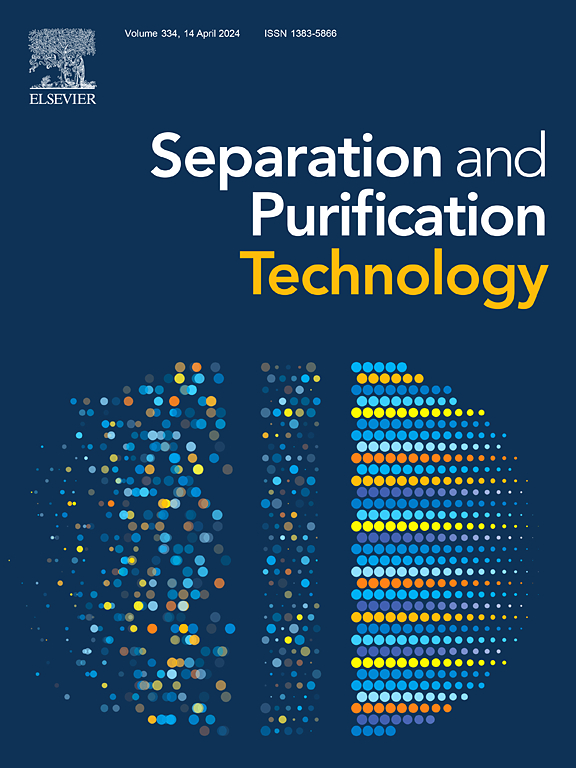基于陶瓷膜的富二氧化碳液体解吸实验研究
IF 8.1
1区 工程技术
Q1 ENGINEERING, CHEMICAL
引用次数: 0
摘要
燃煤电厂的余热利用一直是节能的重要途径之一。本文结合陶瓷膜解吸技术和烟气余热利用技术,构建了一种新型装置。在该装置中,吸收液为 "双阳离子 "离子液体([TEPA][1-MIm])。此外,实验结果表明,疏水陶瓷膜的接触角为 130°。在常温条件下,当乙二醇溶液中的[TEPA][1-MIm]浓度为 25% 时,二氧化碳的最大吸收量约为 1.605 摩尔 CO2/摩尔胺。吸收饱和时间约为 20 分钟。随着离子液体浓度的增加,饱和时间逐渐延长,这是由于[TEPA][1-MIm]的增加以及二氧化碳总吸收量的增加。随后,分析了操作参数对解吸速率的影响。这项工作的贡献在于提出了利用陶瓷膜回收烟气余热以降低二氧化碳解吸能耗的想法。实验结果表明,整体传热系数可达 20.33 W/(m2-K),余热回收量可达 29.97 W。本文章由计算机程序翻译,如有差异,请以英文原文为准。
Experimental investigation on the desorption of CO2 enriched liquids based on ceramic membranes
The waste heat utilization in the coal-fired plant has always been one of important ways of the energy saving. In this paper, a novel device is constructed by the combination of the ceramic membrane desorption and the flue gas waste heat utilization. In the device, the absorption solution is the “double-cationic” ionic liquid ([TEPA][1-MIm]). Furthermore, experimental results show that the contact angle of the hydrophobic ceramic membrane is 130°. Under ambient temperature conditions, it is observed that at a concentration of 25 % [TEPA][1-MIm] in an ethylene glycol solution, the maximum absorption amount of CO2 reaches approximately 1.605 mol CO2/mol amine. The saturation time of the absorption is about 20 min. As the concentration of ionic liquids increases, the saturation time gradually extends due to an increase in [TEPA][1-MIm] and consequently higher total CO2 absorption mass. Subsequently, effects of the operating parameters on the desorption rates are analyzed. The contribution of this work is to put forward the idea of utilizing ceramic membranes to recover the waste heat from the flue gas to reduce the CO2 desorption energy consumption. According to experiments, the overall heat transfer coefficient can reach 20.33 W/(m2·K), and the amount of the recovered waste heat can reach 29.97 W.
求助全文
通过发布文献求助,成功后即可免费获取论文全文。
去求助
来源期刊

Separation and Purification Technology
工程技术-工程:化工
CiteScore
14.00
自引率
12.80%
发文量
2347
审稿时长
43 days
期刊介绍:
Separation and Purification Technology is a premier journal committed to sharing innovative methods for separation and purification in chemical and environmental engineering, encompassing both homogeneous solutions and heterogeneous mixtures. Our scope includes the separation and/or purification of liquids, vapors, and gases, as well as carbon capture and separation techniques. However, it's important to note that methods solely intended for analytical purposes are not within the scope of the journal. Additionally, disciplines such as soil science, polymer science, and metallurgy fall outside the purview of Separation and Purification Technology. Join us in advancing the field of separation and purification methods for sustainable solutions in chemical and environmental engineering.
 求助内容:
求助内容: 应助结果提醒方式:
应助结果提醒方式:


